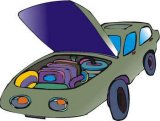
Worksheets and No Prep Teaching Resources
Reading Comprehension Worksheets
Transportation

Transportation
 Worksheets and No Prep Teaching Resources Reading Comprehension Worksheets Transportation |
 Transportation |
| edHelper's suggested reading level: | grades 5 to 7 | |
| Flesch-Kincaid grade level: | 9.48 |
|
The Piston Push
By Trista L. Pollard |

|
 1 What's under the hood of your parents' car? A reciprocating engine lies there, and that is the reason your parents' car has the power to move forward down the street. Reciprocating engines combust or burn fuel inside cylinders within the engine. Similar to other internal-combustion engines (like diesel), reciprocating engines contain pistons that help to convert heat into mechanical energy. Piston-type gasoline engines are the most common type of engines used in automobiles. Let's look inside to see energy at work.
1 What's under the hood of your parents' car? A reciprocating engine lies there, and that is the reason your parents' car has the power to move forward down the street. Reciprocating engines combust or burn fuel inside cylinders within the engine. Similar to other internal-combustion engines (like diesel), reciprocating engines contain pistons that help to convert heat into mechanical energy. Piston-type gasoline engines are the most common type of engines used in automobiles. Let's look inside to see energy at work. |
Create Weekly Reading Books
Prepare for an entire week at once! |
| Leave your feedback on The Piston Push (use this link if you found an error in the story) |
 |
Transportation
|